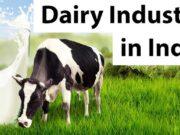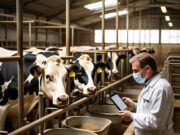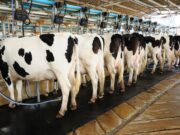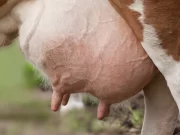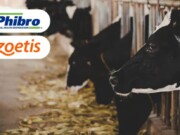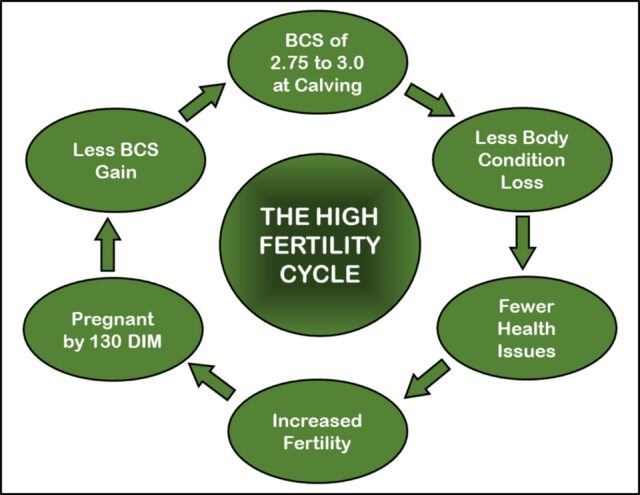
By: Ekta Verma, Bilawal Singh, Reetinder Singh, Prateek Kamboj
The success of a dairy farm depends on its ability to achieve efficient milk production. This, in turn, is significantly reliant on a well-managed reproductive program for the herd. Effective reproductive management ensures timely pregnancies, minimizes calving intervals, and ultimately maximizes milk yield and profitability. This article dwells into the essential aspects of reproductive management in dairy animals, encompassing the key components, strategies, and technologies employed to optimize fertility and enhance productivity. In essence, reproductive management plays a pivotal role in the profitability and sustainability of dairy farming operations. It directly impacts milk production, calf quality, and overall herd health.
- Estrous Cycle: The Cornerstone of Reproductive Management
Effective reproductive management in dairy animals begins with a deep understanding of their reproductive physiology. This intricate system is influenced by a combination of factors, including genetics, nutrition, environment and farm management practices. At the core lies the estrous cycle, a cyclical hormonal interplay involving estrogen and progesterone that governs estrus behavior (heat), ovulation (egg release), and overall fertility. Cows experience this cycle roughly every 21 days, with a heat period lasting 12-24 hours. During heat, behavioral changes like restlessness and mounting activity become evident, signalling the optimal window for breeding.
- Pinpointing the Right Moment: Strategies for Effective Heat Detection
Accurate identification of estrus, the period of receptivity to breeding, is crucial for maximizing conception rates in dairy animals. Traditional methods rely on visual observation of behavioural shifts like standing heat and mounting activity. While valuable, these methods can be labour – intensive and susceptible to human error. Fortunately, technological advancements offer more precise and efficient tools to supplement traditional approaches.
- Advanced Monitoring Systems: Activity monitors, pedometers, and automated estrus detection systems provide continuous data on a cow’s activity levels, body temperature, and potentially even mounting activity. Analyzing this data helps pinpoint subtle changes indicative of estrus, leading to more accurate and timely heat detection.
- Technological Enhancements: Tools like heat-sensitive tail paint offer a simpler method to detect mounting activity, while electronic heat detectors worn on collars or as pedometers offer continuous monitoring of activity and temperature changes. Veterinary tools like vaginal scopes allow for direct examination of the cervix to identify changes in mucus consistency and texture, further confirming impending ovulation.
By combining traditional methods with these advanced technologies, farmers can significantly improve the accuracy and efficiency of estrus detection, leading to more targeted breeding interventions and ultimately, higher pregnancy rates.
- A Multifaceted Approach to Reproductive Health Management
Effective reproductive management goes beyond simply detecting heat. Maintaining optimal reproductive health in the herd is essential for ensuring successful breeding outcomes and maximizing milk production. This requires a multifaceted approach that combines preventative measures with proactive monitoring and intervention.
- Preventative Healthcare: A focus on preventative healthcare plays a crucial role. This includes ensuring cows receive a balanced diet with adequate energy, minerals, and vitamins to support optimal reproductive function. Implementing a strategic vaccination schedule protects cows from diseases that can negatively impact fertility. Regularly monitoring body condition score helps identify nutritional imbalances that could lead to reproductive issues.
- Early Detection and Intervention: Regular monitoring for potential reproductive disorders like endometritis (uterine inflammation), cystic ovaries, and uterine infections is crucial. Veterinarian-conducted reproductive examinations armed with advanced tools like transrectal palpation (internal manual examination), ultrasound imaging, and cytology (microscopic examination of cells) facilitate early detection and treatment of these abnormalities. By promptly addressing these issues, the impact on fertility is minimized, leading to a higher chance of successful pregnancies.
Choosing the Right Breeding Strategy
Once estrus is confirmed, the choice of breeding strategy comes into play. Each method offers unique advantages and considerations:
- Natural Breeding: This traditional method, while cost-effective, presents challenges. Potential injuries to cows or handlers are a concern, and there’s limited genetic control over offspring. Additionally, the risk of spreading diseases becomes a factor.
- Artificial Insemination (AI): AI offers a more controlled approach. Semen from pre-selected, high-performing bulls is collected and deposited directly into the cow’s uterus by a trained technician. This method provides unparalleled control over genetics and herd health. Farmers can leverage the genetic potential of superior bulls, even those located geographically far away, leading to faster genetic improvement of the herd. However, AI requires specialized equipment, training, and careful semen handling procedures.
By implementing a comprehensive reproductive health management program that combines preventative measures with early detection and intervention, farmers can create an environment conducive to optimal fertility. This, coupled with the strategic selection of a breeding strategy based on specific needs, empowers them to maximize pregnancy rates and ultimately, achieve their dairy farming goals.
4. Essential Elements of Reproductive Health Management
Effective reproductive management goes beyond just breeding strategies. It’s about creating an environment conducive to optimal fertility within the herd. This multifaceted approach encompasses several key pillars:
- Nutritional Tailoring: As highlighted earlier, proper nutrition is the cornerstone of reproductive success. Ensuring cows receive a balanced diet rich in energy, essential minerals, and vitamins tailored to their specific needs during different reproductive stages is crucial. This helps maintain a healthy energy balance, reflected in optimal body condition score (BCS). Regularly monitoring BCS allows for adjustments to feeding strategies, preventing both over- and under-conditioning, which can hinder fertility.
- Proactive Protection: Implementing a strategic vaccination program safeguards the herd from diseases like Brucellosis or Bovine Viral Diarrhea (BVD) that can negatively impact reproductive efficiency. By preventing these illnesses, farmers minimize potential disruptions to the breeding cycle.
- Early Intervention: Regular monitoring for potential reproductive issues is essential. Consulting a veterinarian for routine health checkups allows for early detection and treatment of problems like endometritis, cystic ovaries, or uterine infections. This proactive approach minimizes the impact of such issues on fertility and maximizes the chances of successful pregnancies.
- Veterinary Expertise: Veterinarians play a critical role in reproductive health management. Their expertise extends beyond routine checkups. They can perform advanced examinations using tools like transrectal palpation, ultrasound imaging, and cytology to diagnose complex reproductive issues and guide appropriate treatment plans.
By focusing on these core elements, farmers can establish a robust reproductive health management program within their dairy herd. This proactive approach, combined with strategic breeding practices, lays the groundwork for maximizing pregnancy rates and overall herd productivity.
- Advanced Techniques for Enhanced Reproductive Efficiency
Modern technology has ushered in a new era of reproductive management for dairy farms, offering tools that empower farmers to achieve greater control and efficiency:
- Synchronized Breeding with Technological Precision: Estrus synchronization protocols utilize strategically administered hormones to manipulate the estrous cycle in a group of cows. This allows for synchronized breeding, significantly reducing the labor-intensive task of individual heat detection. Additionally, it minimizes the calving interval, leading to more calves per year and increased milk production.
- Sex Selection: Shaping the Future of the Herd: Sexed semen technology takes genetic control to the next level. By employing sperm sorting techniques, this method separates X and Y chromosome-bearing sperm within semen samples. Selecting X chromosome sperm for insemination significantly increases the likelihood of calving heifers, crucial for herd replacement and long-term sustainability.
- Unlocking Genetic Potential: The Power of Embryo Transfer: For high-performing cows, embryo transfer offers a unique opportunity to maximize their genetic potential. This technique involves superovulation, stimulating the production of multiple eggs. These eggs are then fertilized and the resulting embryos are carefully transferred to the uterus of less productive cows for gestation. This allows elite animals to contribute a greater number of offspring with superior genetics to the herd.
- Reproductive Biotechnologies: A Glimpse into the Future
Beyond these established techniques, the field of reproductive biotechnologies continues to evolve rapidly. Advancements in areas like in vitro fertilization (IVF) and genomic selection hold immense promise for the future:
- In Vitro Fertilization (IVF): Similar to embryo transfer, IVF allows for the fertilization of eggs from high-performing cows outside the animal’s body. This opens doors for even greater genetic control and potential manipulation of desirable traits in offspring.
- Genomic Selection: This cutting-edge technology analyzes an animal’s DNA to predict its genetic potential for milk production, disease resistance, and other important traits. Integrating genomic data into breeding programs allows for the selection of breeding stock with exceptional genetic merit, accelerating the rate of genetic improvement in the herd.
While integrating these advanced reproductive biotechnologies into breeding programs requires careful planning, investment, and collaboration with specialized professionals, the potential benefits are undeniable. These techniques offer unparalleled opportunities to enhance genetic progress, improve reproductive efficiency, and ultimately, secure the long-term success and sustainability of dairy farming operations.
- Data Management for Enhanced Reproductive Efficiency
In the realm of dairy farm management, data is king, especially when it comes to reproductive health. Maintaining meticulous reproductive records is an indispensable practice for several reasons:
- Unveiling Fertility Trends: Accurate record-keeping allows farmers to meticulously track key information like breeding dates, insemination outcomes, pregnancy diagnoses, and calving intervals. This data becomes a treasure trove of insights, enabling the calculation of crucial reproductive performance metrics like conception rates, days open (the number of days a cow is not pregnant after calving), and calving intervals. By analyzing these metrics over time, farmers can identify trends, pinpoint potential problems, and evaluate the effectiveness of implemented breeding strategies.
- Data-Driven Decision Making: Armed with these insights, farmers can transform from reactive to proactive managers. Reproductive data analysis allows for informed decision-making on various aspects of the breeding program. For instance, identifying cows with consistently low conception rates may necessitate veterinary intervention or adjustments to breeding protocols.
- Streamlining the Process: Software systems designed specifically for dairy farm management offer a powerful solution for data management. These systems streamline record-keeping processes, ensuring accuracy and eliminating the tediousness of manual recordkeeping. Additionally, they facilitate data analysis by providing user-friendly tools for generating reports and visualizing trends.
By prioritizing accurate reproductive recordkeeping and leveraging the power of data analysis, farmers gain a deeper understanding of their herd’s reproductive performance. This empowers them to make data-driven decisions, optimize breeding strategies, and ultimately, achieve greater reproductive efficiency and overall herd productivity.
- Minimizing Stress for Optimal Reproductive Performance
The success of a reproductive management program extends beyond the cow’s biology. Environmental factors and stressors significantly influence reproductive performance, highlighting the importance of creating a nurturing environment for the herd.
- The Detrimental Impact of Stress: Heat stress, overcrowding, inadequate ventilation, and social stressors like competition for feed and space can disrupt crucial physiological processes. These stressors can suppress estrus expression, hindering heat detection, negatively impacting ovulation, and potentially leading to reduced embryo development and pregnancy rates.
- Proactive Management Strategies: Fortunately, farmers can implement various management practices to mitigate these environmental stressors. Providing adequate shade during hot weather helps regulate body temperature and minimize heat stress. Optimizing housing conditions by ensuring sufficient space, proper ventilation, and comfortable bedding fosters well-being and minimizes social competition. Additionally, implementing heat abatement strategies like sprinklers and fans can further reduce thermal stress, particularly during peak summer months.
By prioritizing environmental management and creating a stress-free environment, farmers can create an environment conducive to optimal reproductive health and performance. This holistic approach, combined with sound breeding practices and data-driven decision-making, paves the way for maximizing pregnancy rates, milk production, and ultimately, the long-term sustainability of dairy farming operations.
Building a Dairy Powerhouse: Mastering Reproductive Management
The key to unlocking a dairy farm’s full potential lies in mastering reproductive management. It’s not just about breeding; it’s a comprehensive strategy. Understanding a cow’s reproductive cycle allows us to leverage advanced tools like heat synchronization and sexed semen for efficient breeding. But it all starts with the right fuel. A balanced diet packed with essential nutrients keeps cows healthy and lays the groundwork for a robust reproductive system.
Prevention is key. Vaccinations shield the herd from fertility-disrupting diseases, while regular vet checkups ensure early detection and treatment of potential problems. By minimizing losses and maximizing efficiency, we achieve sustainable herd improvement. This translates to not only higher profits but also ensures our farms remain viable in the ever-changing agricultural world. Effective reproductive management empowers us to build thriving dairy industries for generations to come.

